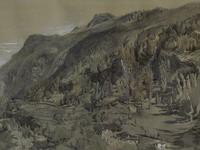John Ruskin and the Geographical Imagination
Denis Cosgrove selects works from Ruskin’s Teaching Collection and reveals a poetry of landscape that inspired geographical learning a century ago.

Over decades of continental travel, Ruskin built a huge collection of finished images of favoured places. The earliest of these were conventionally picturesque; later he sought to capture in art the natural relations of landscapes: 'their very atmospheres are different, their clouds are different, their humours of storm and sunshine are different, their flowers, animals and forests are different.' But Ruskin’s 'mythopoeic science' always sought a symbolic meaning in these differences: 'by each order of landscape … peculiar lessons are intended to be taught.' (3:39)

Stone Pines at Sestri, Gulf of Genoa
This work was made at Cestri, en route from France to the Italian Riviera as Ruskin approached the hills of Carrara. He points out that these pines, sacred to Poseidon, are characteristic of Greek seashores, although Ruskin never visited Greece. 'This piece of landscape, showing a bay of the Mediterranean through the stems of the pines will give you some idea of the mingled grace and strength of the tree, where it grows on crag, and is tried by storms, as among the Greek islands.' (21:116)
'The place itself, a glorious piece of Alpine wilderness, radiant with cascades and flowers among the forest glades – the modern traveller passes beneath it after some eighteen hours’ night and morning travel … and derives much benefit, doubtless, from the dews of morning on those wild-wood glens. But one couldn’t draw them with pen and sepia, I found, not even with one’s best pens in softer grey.' (13:510)

Afternoon in Spring, with South Wind, at Neuchatel
'… the green of a Swiss Lake is pale in the clear waves on the beach, but intense as an emerald in the sunstreak six miles from shore. And in any case, when the foreground is in strong light, or white surface, casting intense reflections, all its colours maybe perfectly delicate, pale, and faint; while the distance, when it is in shadow, may relieve the whole foreground with intense darks of purple, blue green, or ultramarine blue.'
References
All references to Ruskin's writings are taken from The Works of Ruskin, Library Edition, 39 volumes, edited by E.T. Cook and Alexander Wedderburn, George Allen, London, 1903-1912 and given by volume number and page.





